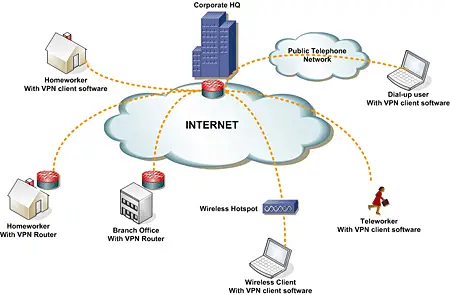Network Security Threats
This article lists five lesser-known threats to network security.
1] Users Of The Network or Stand-Alone Systems
The way users of the network use the computers is one of the most overlooked threats. Users are the ones who spend the most time on the computers on a network. Even if your computer has a firewall at different ports, if a user brings an infected pen drive, all security measures fail. In some cases, the user may connect to the network and leave the computer alone for few minutes. These few minutes can prove costly if someone else decides to take a look at the database. The only method to fight these neglects is to educate the users. Also, be it a standalone computer or a computer on the network, users should be made responsible for problems occurring out of neglect. Read: What are Cloud Security Challenges?
2] Who Is That Person Connecting Through VPN?
VPNs can be a danger as they allow people to connect remotely to the corporate network. While in some cases, organizations provide configured laptops for VPNs, in other cases people might just go ahead and create a VPN connection. The latter can spell doom if not monitored. Other than the person’s intentions, lack of proper security precautions may bring down the network. To avoid problems with VPNs, it is suggested that you make a list of authorized machines and allow only these machines to connect via VPN. You can also set up an audit to check who all are connecting to the network using what machines and why.
3] Outdated Applications Are A Liability
In some networks, they continue using an older version of applications (for example, Outlook Express) for unwillingness to spend on the upgrades. Spending here refers to both money and time. Older applications may be running easily on your computer/network, but they are a threat in a sense that they can easily be taken over by malicious people on/off the network. Older legacy applications also tend to break down more compared to newer versions. It is recommended that you check out the cost of the upgrade. If it is okay, upgrade or else move to an entirely new application with similar functionality. For example, if you are still using “FoxPro for DOS” type applications, you might want to move to Visual FoxPro to make sure your programs are current with security installed.
4] Old Servers Running An Impossible Program
Almost all networks have one or more servers that run older programs or operating systems. These servers cannot be updated as support is no longer available. Such servers though appear to be working fine, are a big risk to the network. You know that the server won’t break down. But it sure can be hijacked by prying eyes on the network. The best method is to virtualize the programs that the ancient servers are running. This way, you can try and upgrade the programs. Alternatively, you can shed the entire program and go for a replacement.
5] Local Administrators Are Always A Threat
More than often, local admins are the people given special privileges just to troubleshoot something on the computer. Once the troubleshooting is over, admin privileges should be revoked but the IT people forget to do so. In such a case, the local admin user account will invite problems one or the other day. The best method to deal with local admins is to create profiles that auto-expire. These were five lesser-known threats to network security, in my opinion. If you wish to add or feel I have missed out something, please leave a note below.

